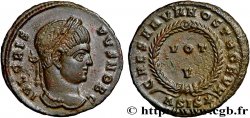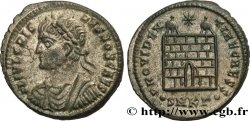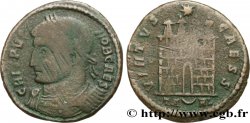E-auction 150-88810 - brm_283330 - CRISPUS Centenionalis ou nummus
You must signin and be an approved bidder to bid, LOGIN TO BID. Accounts are subject to approval and the approval process takes place within 48 hours. Do not wait until the day a sale closes to register. Clicking on « bid » constitutes acceptance of the terms of use of cgb.fr private e-auctions.
Bids must be placed in whole Euro amounts only. The sale will start closing at the time stated on the item description; any bids received at the site after the closing time will not be executed. Transmission times may vary and bids could be rejected if you wait until the last second. For further information ckeck the E-auctions F.A.Q.
NO BUYER'S FEE.
NO BUYER'S FEE.
| Estimate : | 195 € |
| Price : | 68 € |
| Maximum bid : | 79 € |
| End of the sale : | 29 February 2016 14:36:00 |
| bidders : | 8 bidders |
Type : Centenionalis ou nummus
Date: mars
Date: 321
Mint name / Town : Lyon
Metal : copper
Diameter : 20 mm
Orientation dies : 6 h.
Weight : 3,39 g.
Rarity : R3
Coments on the condition:
Exemplaire sur un flan large, bien centré des deux côtés. Beau portrait de Constantin II à l’usure régulière. Revers inhabituel. Belle patine vert foncé
Catalogue references :
Predigree :
Cet exemplaire provient de la collection du baron L. Chaurand (Lyon
Obverse
Obverse legend : D N CRISPO - NOB CAES.
Obverse description : Tête laurée de Crispus à droite (O*).
Obverse translation : “Domino Nostro Crispo Nobilissimo Cæsari”, (À notre seigneur Crispus très noble césar).
Reverse
Reverse legend : CONSTANTINI AVG/ VO/TIS/ XX// PL.
Reverse description : Légende en trois lignes.
Reverse translation : “Constantini Augusti/ Votis vicennalibus”, (de Constantin auguste/ vœux pour le vingtième anniversaire de règne).
Commentary
Ruban de type 1. Cet exemplaire est illustré dans l’ouvrage de P. Bastien, p. 142, n° 32b, pl. II. Ce type est de la plus grande rareté. P. Bastien avait recensé dix exemplaires pour cinq numéros pour cette émission de transitionet seulement deux pour notre type dont celui de la collection du baron L. Chaurand, l’autre provenant du Cabinet des médailles de la BnF.








 Report a mistake
Report a mistake Print the page
Print the page Share my selection
Share my selection Ask a question
Ask a question Consign / sell
Consign / sell
 Full data
Full data








